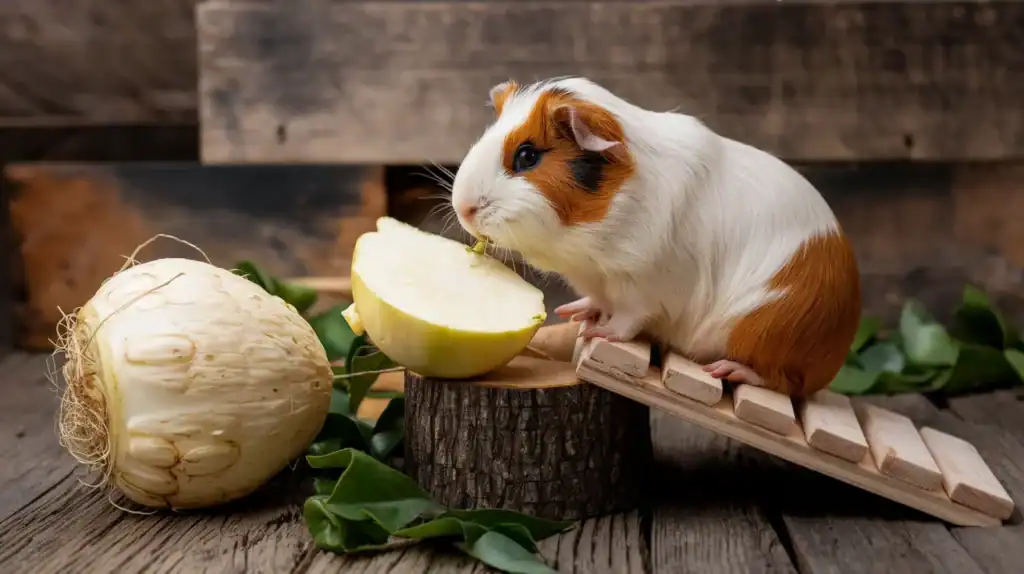Caring for guinea pigs means providing them with a diet rich in nutrients, but not all vegetables are safe for these small pets. Can guinea pigs eat celeriac? This root vegetable, often mistaken for celery, has a unique nutritional profile that may or may not be suitable for guinea pigs.
In this comprehensive guide, we’ll explore the benefits, risks, and proper feeding methods for celeriac in a guinea pig’s diet. You’ll also find detailed nutritional information, comparisons with other vegetables, and practical feeding tips to ensure your guinea pig stays happy and healthy.
What is Celeriac?
Celeriac (Apium graveolens var. rapaceum), also known as celery root, is a knobby, root-like vegetable related to celery. While it has a mild celery flavor, it is distinct from the green stalks commonly used in cooking.
Key Characteristics of Celeriac:
- Botanical family: Apiaceae (same as celery and carrots)
- Edible parts: Primarily the root, but leaves are also edible
- Texture: Firm, similar to turnips or potatoes
- Taste: Mildly sweet and nutty with a hint of celery
Celeriac is often used in human dishes like soups, purees, and salads, but does this mean it’s suitable for guinea pigs?
Celeriac vs. Celery and Carrots: What’s the Difference?
Celeriac is often compared to celery and carrots, two common vegetables in a guinea pig’s diet. However, they differ in nutritional content, making some better suited for guinea pigs than others.
| Nutrient (per 100g) | Celeriac | Celery | Carrots |
| Vitamin C | 8 mg | 3 mg | 5.9 mg |
| Fiber | 1.8 g | 1.6 g | 2.8 g |
| Calcium | 43 mg | 40 mg | 33 mg |
| Sugar | 1.6 g | 1.3 g | 4.7 g |
| Water content | 88% | 95% | 88% |
Celery has the highest water content but the least vitamin C.- Carrots contain more sugar, which can be problematic for guinea pigs.
- Celeriac has slightly more vitamin C than celery but less than ideal for guinea pigs.
Nutritional Breakdown of Celeriac for Guinea Pigs
Vitamin C Content
Vitamin C is essential for guinea pigs since they cannot produce it naturally. Celeriac contains around 8 mg of vitamin C per 100g, which is low compared to bell peppers or parsley, which are far better sources of this crucial vitamin.
Fiber Content
Guinea pigs need fiber to maintain a healthy digestive system. Celeriac has 1.8g of fiber per 100g, which is decent but lower than other fibrous veggies like kale or spinach.
Calcium Content
Excess calcium can contribute to bladder stones in guinea pigs. Celeriac contains 43 mg of calcium per 100g, making it a moderate source. Feeding too much may lead to urinary issues over time.
Sugar Content
High sugar intake can cause obesity and digestive problems in guinea pigs. With 1.6g of sugar per 100g, celeriac is relatively low in sugar, making it a better choice than carrots.
Water Content
Celeriac has 88% water, which helps keep guinea pigs hydrated but may also cause diarrhea if fed in excess.
Benefits of Feeding Celeriac to Guinea Pigs
When given in moderation, celeriac can offer several benefits:
- Supports digestion – Its fiber content helps maintain gut health.
- Hydration – The high water content contributes to fluid intake.
- Low in sugar – A better alternative to carrots for guinea pigs.
- Provides essential minerals – Contains potassium, phosphorus, and magnesium.
Risks and Concerns of Celeriac for Guinea Pigs
While celeriac has benefits, there are risks to consider:
- Low in vitamin C – Not a reliable primary source for guinea pigs.
- Moderate calcium levels – Can contribute to bladder stones if fed excessively.
- Potential digestive issues – Can cause bloating and diarrhea if given in large amounts.
- Pesticide exposure – Non-organic celeriac may contain harmful chemicals; always wash thoroughly.
How to Safely Feed Celeriac to Guinea Pigs
To minimize risks and maximize benefits, follow these feeding guidelines:
Preparation Steps
- Choose fresh, organic celeriac to avoid pesticide residues.
- Peel the rough outer layer to remove any dirt or contaminants.
- Chop into small, bite-sized pieces for easy eating.
- Serve it raw—cooked celeriac loses nutrients and is harder to digest.
Recommended Portion Size & Frequency
- Portion size: A small piece (around 1-inch cube) per feeding.
- Frequency: No more than 1-2 times per week to prevent excess calcium intake.
Mixing with Other Foods
To balance nutrition, combine celeriac with:
- Vitamin C-rich veggies like bell peppers and parsley.
- Leafy greens like romaine lettuce or cilantro.
- Hay-based diet to support proper digestion.
Alternative Vegetables for Guinea Pigs
If you’re looking for better veggie options, consider these:
| Vegetable | Benefits |
| Bell Peppers | High in vitamin C, low in calcium |
| Cucumber | Hydrating, low in sugar |
| Zucchini | Low in calories, rich in antioxidants |
| Leafy Greens | Excellent fiber and vitamin content |
Final Verdict: Should Guinea Pigs Eat Celeriac?
Celeriac is not toxic to guinea pigs, but it should only be given occasionally. While it offers hydration, fiber, and some vitamins, its low vitamin C content and moderate calcium levels mean it’s not the best staple food for guinea pigs.
Key Takeaways:
- Can guinea pigs eat celeriac? Yes, but in moderation.
- How often should they eat it? No more than 1-2 times per week.
- Better alternatives? Bell peppers, leafy greens, and cucumbers are healthier choices.
Nutritional Information for Celeriac (Per 100g)
| Nutrient | Amount |
| Calories | 42 kcal |
| Vitamin C | 8 mg |
| Fiber | 1.8 g |
| Calcium | 43 mg |
| Sugar | 1.6 g |
| Water | 88% |

